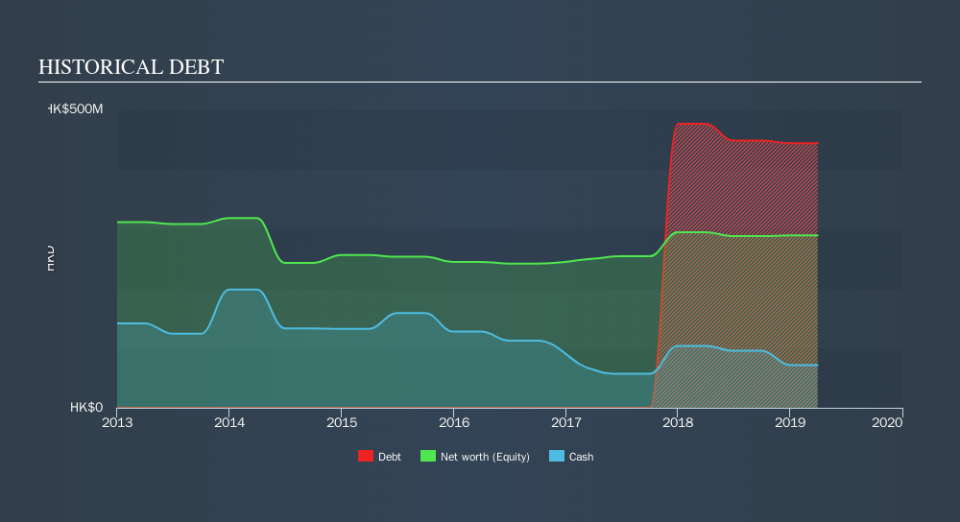Qingdao Holdings International (HKG:499) Has A Mountain Of Debt

David Iben put it well when he said, 'Volatility is not a risk we care about. What we care about is avoiding the permanent loss of capital. So it seems the smart money knows that debt - which is usually involved in bankruptcies - is a very important factor, when you assess how risky a company is. We note that Qingdao Holdings International Limited (HKG:499) does have debt on its balance sheet. But is this debt a concern to shareholders?
Why Does Debt Bring Risk?
Debt is a tool to help businesses grow, but if a business is incapable of paying off its lenders, then it exists at their mercy. Part and parcel of capitalism is the process of 'creative destruction' where failed businesses are mercilessly liquidated by their bankers. While that is not too common, we often do see indebted companies permanently diluting shareholders because lenders force them to raise capital at a distressed price. By replacing dilution, though, debt can be an extremely good tool for businesses that need capital to invest in growth at high rates of return. The first thing to do when considering how much debt a business uses is to look at its cash and debt together.
View our latest analysis for Qingdao Holdings International
What Is Qingdao Holdings International's Net Debt?
The image below, which you can click on for greater detail, shows that Qingdao Holdings International had debt of HK$443.3m at the end of March 2019, a reduction from HK$475.9m over a year. On the flip side, it has HK$71.4m in cash leading to net debt of about HK$371.9m.
How Healthy Is Qingdao Holdings International's Balance Sheet?
The latest balance sheet data shows that Qingdao Holdings International had liabilities of HK$10.00m due within a year, and liabilities of HK$443.7m falling due after that. Offsetting these obligations, it had cash of HK$71.4m as well as receivables valued at HK$27.2m due within 12 months. So it has liabilities totalling HK$355.1m more than its cash and near-term receivables, combined.
When you consider that this deficiency exceeds the company's HK$289.6m market capitalization, you might well be inclined to review the balance sheet intently. In the scenario where the company had to clean up its balance sheet quickly, it seems likely shareholders would suffer extensive dilution.
We use two main ratios to inform us about debt levels relative to earnings. The first is net debt divided by earnings before interest, tax, depreciation, and amortization (EBITDA), while the second is how many times its earnings before interest and tax (EBIT) covers its interest expense (or its interest cover, for short). Thus we consider debt relative to earnings both with and without depreciation and amortization expenses.
Qingdao Holdings International shareholders face the double whammy of a high net debt to EBITDA ratio (17.0), and fairly weak interest coverage, since EBIT is just 0.93 times the interest expense. This means we'd consider it to have a heavy debt load. However, the silver lining was that Qingdao Holdings International achieved a positive EBIT of HK$17m in the last twelve months, an improvement on the prior year's loss. The balance sheet is clearly the area to focus on when you are analysing debt. But you can't view debt in total isolation; since Qingdao Holdings International will need earnings to service that debt. So when considering debt, it's definitely worth looking at the earnings trend. Click here for an interactive snapshot.
Finally, a business needs free cash flow to pay off debt; accounting profits just don't cut it. So it is important to check how much of its earnings before interest and tax (EBIT) converts to actual free cash flow. Over the last year, Qingdao Holdings International saw substantial negative free cash flow, in total. While that may be a result of expenditure for growth, it does make the debt far more risky.
Our View
To be frank both Qingdao Holdings International's interest cover and its track record of converting EBIT to free cash flow make us rather uncomfortable with its debt levels. But at least its EBIT growth rate is not so bad. Taking into account all the aforementioned factors, it looks like Qingdao Holdings International has too much debt. That sort of riskiness is ok for some, but it certainly doesn't float our boat. Above most other metrics, we think its important to track how fast earnings per share is growing, if at all. If you've also come to that realization, you're in luck, because today you can view this interactive graph of Qingdao Holdings International's earnings per share history for free.
At the end of the day, it's often better to focus on companies that are free from net debt. You can access our special list of such companies (all with a track record of profit growth). It's free.
We aim to bring you long-term focused research analysis driven by fundamental data. Note that our analysis may not factor in the latest price-sensitive company announcements or qualitative material.
If you spot an error that warrants correction, please contact the editor at editorial-team@simplywallst.com. This article by Simply Wall St is general in nature. It does not constitute a recommendation to buy or sell any stock, and does not take account of your objectives, or your financial situation. Simply Wall St has no position in the stocks mentioned. Thank you for reading.

